
Agave americana, commonly known as the century plant, maguey, or American aloe, is a flowering plant species belonging to the family Asparagaceae. It is native to Mexico and the United States, specifically Texas. This plant is widely cultivated worldwide for its ornamental value and has become naturalized in various regions, including Southern California, the West Indies, South America, the Mediterranean Basin, Africa, the Canary Islands, India, China, Thailand, and Australia.

Agave attenuata is a species of flowering plant in the family Asparagaceae, commonly known as the foxtail or lion's tail. The name swan's neck agave refers to its development of a curved inflorescence, unusual among agaves. Native to the plateaux of central west Mexico, as one of the unarmed agaves, it is popular as an ornamental plant in gardens in many other places with subtropical and warm climates.

Agave bracteosa is a species of agave sometimes known as spider agave or squid agave. It is native to the Sierra Madre Oriental of México, where it prefers well-drained and shaded or semi-protected locations on cliffs and rocky slopes from 900 to 1,700 meters. Although it occupies a small range, it is not considered to be threatened.

Agave lechuguilla is an Agave species found only in the Chihuahuan Desert. The plant flowers once in its life and then dies.

Abies religiosa, the oyamel fir or sacred fir, is a fir native to the mountains of central and southern Mexico and western Guatemala. It grows at high elevations of 2,100–4,100 metres (6,900–13,500 ft) in cloud forests with cool, humid summers and dry winters in most of its habitat regime. In the state of Veracruz, it grows with precipitation all year long. The tree is resistant to regular winter snowfalls.

Agave bovicornuta Gentry, is a plant in the genus Agave, native to mountainous regions in the Mexican states of Chihuahua, Sonora and Sinaloa. The common name Cowhorn Agave and the specific epithet refer to the prominent red spines along the edges of the leaves. Other common names include "lechguilla verde"

Agave angustifolia is a species of agave plant which is native to Mexico and Central America. It is used to make mezcal and also as an ornamental plant. The cultivar 'Marginata' that white margins on the leaves is a popular variety cultivated in botanical gardens and backyards. It is very closely related to blue agave Agave tequilana, but is used to make the distilled alcoholic beverage mezcal instead of tequila, and is the predominant agave species grown in the Mexican state of Oaxaca.

Agave mitis is a plant species native to the Mexican states of Hidalgo, Tamaulipas and San Luis Potosí, referred to as Agave celsii in many publications.

Agave salmiana is a species of the family Asparagaceae, native to central and southern Mexico. It is also reportedly naturalized in South Africa, Italy and Spain, specially in the Canary Islands.
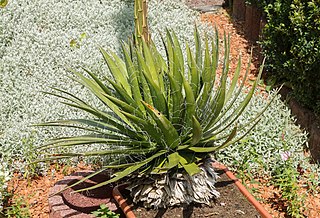
Agave filifera, the thread agave, is a species of flowering plant in the family Asparagaceae, native to Central Mexico from Querétaro to Mexico State. It is a small or medium-sized succulent plant that forms stemless rosette up to 3 feet (91 cm) across and up to 2 feet (61 cm) tall. The leaves are dark green to a bronzish-green in color and have very ornamental white bud imprints. The flower stalk is up to 11.5 feet (3.5 m) tall and is densely loaded with yellowish-green to dark purple flowers up to 2 inches (5.1 cm) long. Flowers appear in autumn and winter.
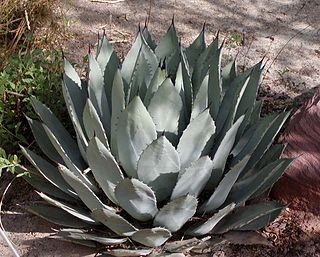
Agave palmeri is an especially large member of the genus Agave, in the family Asparagaceae.
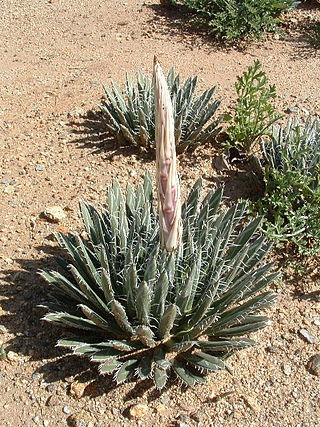
Agave polianthiflora is a relatively small member of the genus Agave, in the subfamily Agavoideae, endemic to northern Mexico.

Agave xylonacantha is a plant species native to Hidalgo, Tamaulipas, Guanajuato and Queretaro in Mexico, but commonly cultivated as an ornamental on other regions. A. xylonacantha is an easy-to-grow member of the genus Agave. The specific epithet 'xylonacantha' means "wood spines".

Agave striata is a plant species native to Northeastern Mexico. Because the species is widespread and does not appear to be under any significant threats, it is not considered by the IUCN to be threatened.

Yucca jaliscensis is a Yucca species native to the highlands of southwestern Mexico. Common names for this species include Jalisco Yucca, Jalisco Soapwort, Izote Yucca. It is native to mountainous areas at about 5000 feet in the States of Jalisco, Colima and Guanajuato.

Yucca madrensisH. S. Gentry is a plant in the genus Yucca in the family Asparagaceae. It is native to a mountainous region in the Sierra Madre Occidental in the Mexican states of Sonora and Chihuahua. It has also been reported from Arizona It grows on steep, rocky slopes in pine-oak forests.
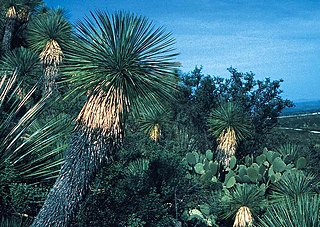
Yucca linearifolia is a plant species in the family Asparagaceae, native to the Chihuahuan Desert in the Mexican states of Coahuila and Nuevo Leon. It is a tree-like perennial up to 3.5 m tall, with narrow, denticulate leaves and fleshy fruits.

Erythrina flabelliformis, common name chilicote or western coral bean, is a plant species native to central and northwestern Mexico and the southwestern United States. It is known from Baja California as far south as Morelos and as far east as San Luis Potosí, as well as from Arizona and New Mexico.
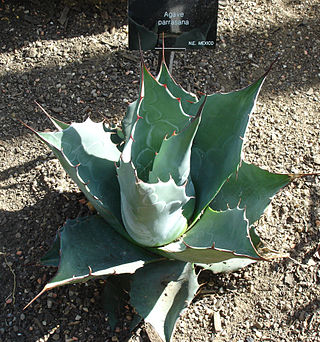
Agave parrasana, the cabbage head agave or cabbage head century plant, is a flowering plant in the family Asparagaceae. A slow-growing evergreen succulent from North East Mexico, it produces a compact rosette of fleshy thorn-tipped grey-green leaves, 60 cm tall and wide. The leaves are blue green and the thorns are red. The whole plant may reach 100 centimeters tall and wide. Occasionally, mature plants produce a spectacular flower head up to 6m tall, opening red and turning yellow. This signals the death of the flowering rosette. However, offsets may form and continue growing.





















